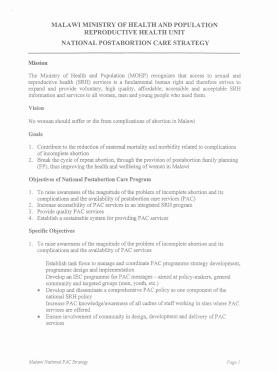Malawi Ministry of Health And Population Reproductive Health Unit National Postabortion Care Strategy
Malawi Ministry of Health And Population Reproductive Health Unit National Postabortion Care Strategy
Complications from spontaneous and induced abortions - primarily hemorrhage, infection and injury to the genital tract - remain a serious threat to the health of women in Malawi. These complications account for as much as 60% of acute gynaecological admissions into both public and private health facilities in Malawi (Kinoti et al, 1995). As well, an estimated 30% of maternal mortality in Malawi is due to complications of abortion (Mtimavalye, 1996). Cognisant of the WHO estimate that for every case of maternal mortality there are 10-15 women who sustain serious morbidities, and the high national maternal mortality rate of 1,12011 00,000 live births (The National Statistical Office, The Demographic and Health Survey - 2000), it is clear that abortion complications significantly contribute to maternal morbidity and mortality in Malawi.
Adolescents comprise a large percentage of those women presenting with complications from unsafe abortion; fully 50% of cases treated at Queen Elizabeth Central Hospital in 1998 were adolescents (MOHP/JHPIEGO RH training needs assessment, 1999). Similarly, in 1999, 60% of cases treated at Rurnphi District Hospital were adolescents, 60% at Nkhata Bay District Hospital and 50% at Kasungu District Hospital (MOHP/JHPIEGO PAC district needs assessment, 2000). These adolescents represent a key group to target under a national PAC programme in order to improve their access to and acceptance of FP services.
In most health facilities in Malawi there is only one operating theatre that is often utilised for various surgical emergencies, including caesarian section, ectopic pregnancy, trauma and other surgical emergencies. These emergencies receive priority over women who present with abortion complications, which delays management and augments the risk of complications, including death. There is also an acute shortage of the necessary surgical equipment, instruments and supplies required to provide safe and high quality PAC services. Even when
there is more than one theatre, and equipment and supplies are in sufficient quantity, there is a tremendous lack of competent clinical personnel to provide quality comprehensive postabortion care. All of these factors stand in the way of Malawian women and young girls being able to access quality postabortion care services.

